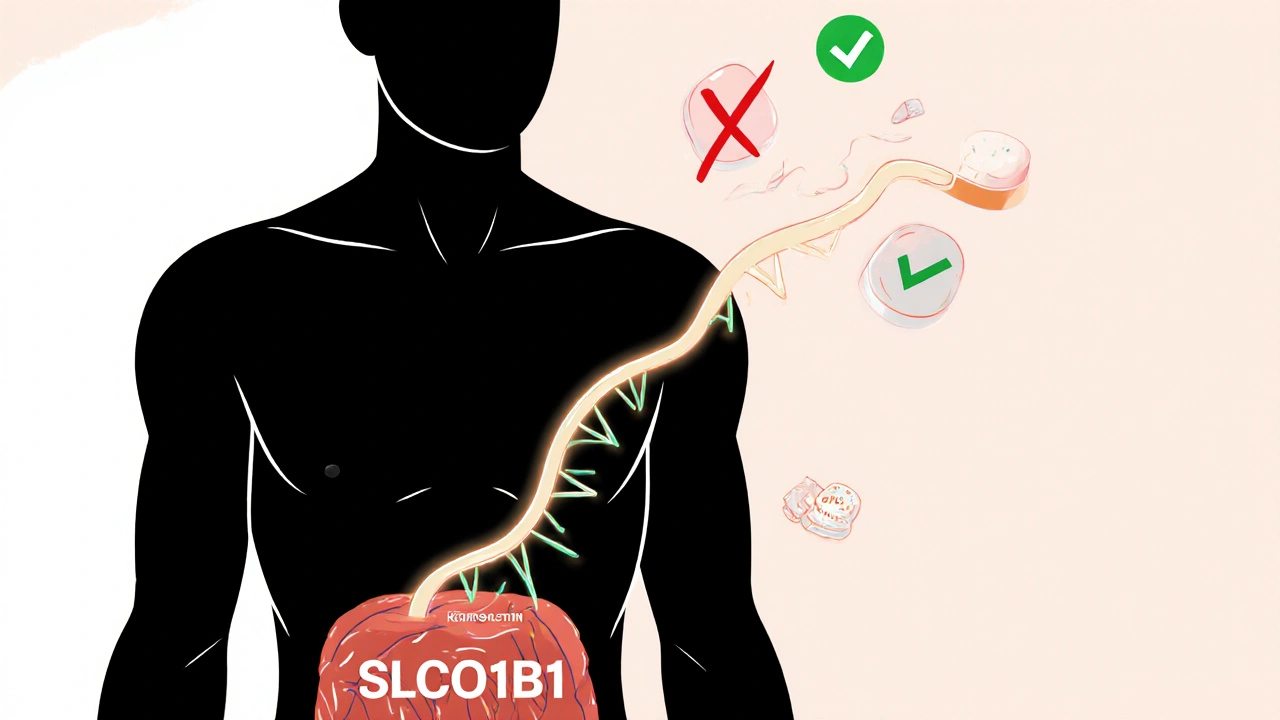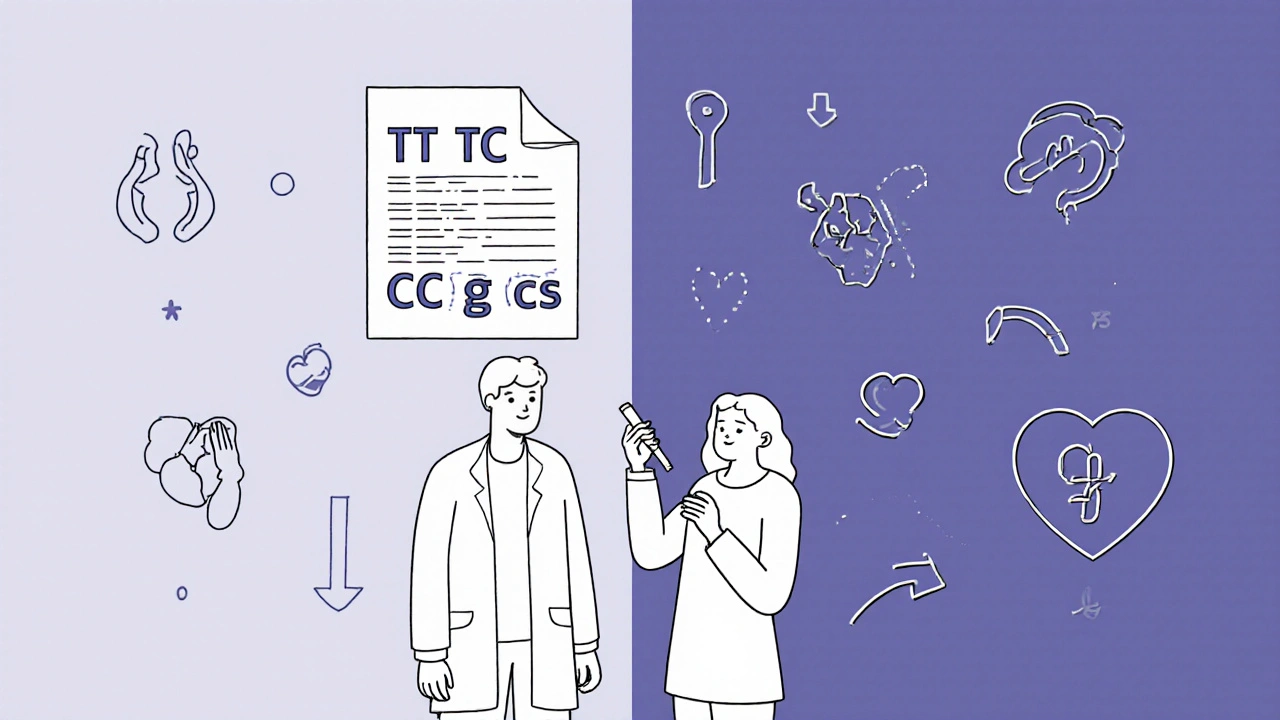Genetic Factors in Statin Tolerance: How Pharmacogenomics Testing Can Help

- Colin Hurd
- 22 November 2025
- 15 Comments
Statin Tolerance Guide
Your Genetic Profile
Select your SLCO1B1 genotype to see which statins may be best for you based on the latest research.
Personalized Statin Recommendations
What this means:
SLCO1B1 gene variants affect how your liver processes statins. A CC genotype means you may have higher risk of muscle pain with certain statins, especially simvastatin at high doses. Your doctor may recommend alternative statins or lower doses.
If you’ve been told to take a statin but kept having muscle pain, fatigue, or weakness - and your doctor couldn’t explain why - you’re not alone. About 7 to 29% of people who take statins report muscle-related side effects, and for many, it’s not just a minor annoyance. It’s enough to make them stop the medication entirely. But what if the problem isn’t your lifestyle, your age, or even the drug itself? What if it’s in your genes?
Why Some People Can’t Tolerate Statins
Statins are among the most prescribed drugs in the world. Over 35 million Americans take them to lower cholesterol and reduce heart attack risk. But for a significant number of people, the benefits come with a cost: muscle pain, cramps, or even rare but serious muscle damage. This isn’t just bad luck. Research shows genetics play a major role. The key player here is a gene called SLCO1B1. This gene makes a protein that helps your liver pull statins out of your bloodstream. If your version of this gene has a specific variant - called rs4149056 or the C allele - your liver doesn’t absorb statins as well. That means more of the drug stays in your blood, increasing the chance of muscle damage. This isn’t theoretical. A landmark 2008 study found that people with two copies of the C variant (CC genotype) had a 4.5 times higher risk of severe muscle injury when taking high-dose simvastatin. Even one copy (TC genotype) raised the risk by 2.6 times. These numbers aren’t small. They’re clinically meaningful.Not All Statins Are Created Equal
Here’s where it gets important: this genetic risk doesn’t apply to all statins. The link between SLCO1B1 and muscle problems is strongest with simvastatin, especially at 80 mg doses. For atorvastatin or rosuvastatin, the same genetic variant doesn’t show the same strong connection. That’s why clinical guidelines from the Clinical Pharmacogenetics Implementation Consortium (CPIC) only recommend adjusting simvastatin dosing based on SLCO1B1 results. If you’re a CC carrier, you’re told to avoid simvastatin 80 mg. But you’re not told to avoid statins altogether. The good news? You have options. Pravastatin and fluvastatin are metabolized differently. They don’t rely as much on the OATP1B1 transporter. Studies show people with the high-risk CC genotype have up to 80% lower risk of muscle problems on pravastatin compared to simvastatin. For many, switching statins - not stopping them - is the solution.What Does Pharmacogenomics Testing Actually Show?
Pharmacogenomics testing for statin tolerance usually means checking your SLCO1B1 gene. It’s done with a simple cheek swab or blood draw. Results come back in about a week. The report will tell you if you’re TT (normal), TC (intermediate risk), or CC (high risk). But here’s the catch: SLCO1B1 only explains about 6% of all statin-related muscle symptoms. That means most people with muscle pain don’t have this variant. Other genes like CYP2D6, ABCB1, and even SOAT1 are being studied, but none are used routinely yet. So a negative test doesn’t rule out intolerance - it just rules out one specific genetic cause. Some labs, like Mayo Clinic and ARUP, offer comprehensive panels that include multiple genes. Others, especially direct-to-consumer tests, give raw data without interpretation. That’s risky. Without a doctor or pharmacist to explain the results, you might misinterpret a low-risk result as a green light to take any statin - even if your body reacts poorly for other reasons.
Who Should Get Tested?
Testing isn’t for everyone. The American College of Cardiology doesn’t recommend routine testing for all patients starting statins. But they do say it’s reasonable to test if:- You had muscle symptoms with one statin and want to try another
- You’re considering high-dose simvastatin
- You’ve stopped statins before due to muscle pain and want to restart safely
Real Stories, Real Results
One 54-year-old woman from Ohio had been off statins for three years after simvastatin gave her debilitating leg cramps. Her LDL stayed above 160. She got tested and found out she was CC genotype. Her doctor switched her to pravastatin. Within six months, her LDL dropped to 92. No muscle pain. She’s been on it for 18 months now. Another man in Texas had tried three different statins - all caused muscle aches. His test showed no SLCO1B1 risk. His doctor then looked at his CYP3A4 metabolism and found he was a slow metabolizer. He switched to rosuvastatin, which is less affected by that enzyme. His symptoms cleared up. These aren’t rare cases. They’re examples of precision medicine working - when the right test is used at the right time.
Barriers to Getting Tested
Even with solid science, testing isn’t easy. Insurance coverage is patchy. As of 2022, only 28% of commercial insurers covered SLCO1B1 testing. Out-of-pocket costs range from $150 to $400. Medicare rarely covers it unless it’s part of a specific program. Doctors are another hurdle. A 2021 survey found only 43% of primary care physicians felt confident interpreting pharmacogenomic results. Cardiologists are better trained - 82% said they were comfortable with it. But most patients start with their PCP. Electronic health records are starting to help. Systems like Epic and Cerner now flag high-risk genotypes when simvastatin is prescribed. But not all clinics have this set up. If you’re asking for a test, you might need to push for it.What’s Next?
The future of statin pharmacogenomics isn’t just about one gene. Researchers are building polygenic risk scores that combine SLCO1B1 with other variants - ABCB1, GATM, CACNA1S, and more. Early studies show these can improve prediction accuracy from 58% to 67%. That’s still not perfect, but it’s moving in the right direction. In 2023, a new group called the Statin Pharmacogenomics Implementation Consortium launched with a goal to standardize testing across 50 U.S. health systems by 2025. That’s a big step toward making this routine. For now, the message is clear: if you’ve struggled with statin side effects, don’t assume you’re just sensitive to the drug. Ask about genetic testing - especially if you’re considering simvastatin. It might not explain everything, but it can explain enough to get you back on a medication that saves your life.What to Do Next
If you’ve had trouble with statins:- Don’t give up on statins - give up on the wrong one.
- Ask your doctor if SLCO1B1 testing is right for you.
- If you’re on simvastatin 80 mg and have muscle symptoms, consider switching to pravastatin or rosuvastatin - even before testing.
- Use resources like PharmGKB to understand your results (it’s free and evidence-based).
- If your doctor isn’t familiar with pharmacogenomics, ask for a referral to a cardiologist or clinical pharmacist.




Comments
David Cunningham
Been on rosuvastatin for 5 years now. Zero muscle issues. Switched after simvastatin wrecked my legs. Genetics might’ve played a part, but honestly? Just try a different statin before you pay for a test.
November 24, 2025 AT 12:11
ann smith
This is such an important post. I had the same thing - thought I was just ‘sensitive’ until I got tested. CC genotype. Switched to pravastatin and I’m finally sleeping through the night again. No more 3 a.m. cramps. You’re not broken. Your genes just need a different tool. 💪❤️
November 25, 2025 AT 22:19
Rahul Kanakarajan
So let me get this straight - you want me to pay $400 to find out I can’t take simvastatin? Why didn’t my doctor just tell me to try something else first? This feels like corporate medicine selling tests to avoid responsibility. I’ve been on atorvastatin for a decade. Never had a problem. Why is this even a thing?
November 26, 2025 AT 21:17
New Yorkers
Genes are destiny, but doctors are the priests of the pharmaceutical cult. You think SLCO1B1 is the answer? What about the 94% of cases it doesn’t explain? We’re treating symptoms with data while ignoring the real question: why are we poisoning people with statins in the first place? The real genetic flaw is trusting Big Pharma.
November 28, 2025 AT 00:12
manish chaturvedi
In India, most doctors don’t even know what pharmacogenomics means. I had to fly to Bangalore to get tested after my statin intolerance. Took 3 months. But once I got the results - CC genotype - my cardiologist switched me to fluvastatin. No more pain. It’s not magic. It’s science. And yes, it’s worth fighting for.
November 29, 2025 AT 02:33
luke young
My dad had statin issues for years. Thought he was just getting old. Got tested after I nagged him. Turned out he was TC. Switched to pravastatin. Now he hikes every weekend. Honestly, if you’ve had muscle pain and quit statins - just ask. No shame. This isn’t about weakness. It’s about smart medicine.
November 30, 2025 AT 07:37
Nikhil Chaurasia
I read this and thought - finally, someone gets it. My sister tried 4 statins. All failed. We thought it was her diet. Turns out, she’s CC. Pravastatin fixed everything. I’m so glad this info is out there. People need to know they’re not failing - their bodies are just wired differently.
November 30, 2025 AT 10:08
Holly Schumacher
Let’s be precise: the 2008 study cited used simvastatin 80mg - a dose that was already withdrawn in the US in 2010 due to safety concerns. So your entire argument hinges on a discontinued dosage. That’s not pharmacogenomics. That’s retrospective cherry-picking. Also, ‘up to 80% lower risk’? That’s not a mean, it’s a maximum from a subgroup. Please stop overstating effect sizes.
November 30, 2025 AT 18:09
Michael Fitzpatrick
I’ve been thinking about this a lot. I mean, if your liver can’t handle statins because of your genes, that’s not really a side effect - it’s a biological mismatch, right? Like trying to plug a USB-C into a micro-USB port. The cable’s fine, the port’s just not made for it. And honestly, I think we should be testing everyone before prescribing, not waiting for someone to get sick. It’s cheaper than ER visits. Plus, imagine if we did this for antidepressants too? We could save so many people from years of trial and error. Just a thought.
December 1, 2025 AT 18:36
Shawn Daughhetee
my doc just gave me a script for simvastatin and said ‘take it’ i was like ‘but my legs hurt last time’ he said ‘maybe you’re just weak’ so i googled and found this. got tested. cc. switched to rosuvastatin. no more pain. why do doctors not know this??
December 2, 2025 AT 22:52
Miruna Alexandru
The fact that this is even a conversation reveals how fragmented modern medicine is. We’re reducing complex physiological responses to single SNPs while ignoring systemic issues like inflammation, mitochondrial dysfunction, and coenzyme Q10 depletion. SLCO1B1 is a red herring - a convenient proxy for a lack of holistic understanding. You’re treating a symptom of a broken system with a $300 test.
December 3, 2025 AT 18:23
Justin Daniel
My cousin got tested after her doctor said she ‘just needed to push through the pain.’ She’s CC. Switched to pravastatin. Now she’s hiking Machu Picchu next month. Meanwhile, my uncle’s still on simvastatin 80mg because his doctor ‘doesn’t believe in gene stuff.’ So… yeah. This isn’t just science. It’s survival.
December 4, 2025 AT 16:51
Melvina Zelee
my mom was so scared to take statins after her cramps… but then she got tested and it was like… ohhh so it’s not me being weak?? i cried. we switched to pravastatin and now she’s biking again. i wish every doc had this info. it’s not magic, it’s just… knowing. like finally having the right key for a lock you’ve been forcing for years
December 5, 2025 AT 10:42
steve o'connor
Had the test done last year. TC genotype. Switched from simvastatin to rosuvastatin. No issues. But honestly? The real win was getting my doctor to actually listen. Before that, I felt like I was just complaining. Now I feel like I’m being treated like a person, not a number. That’s worth more than any gene result.
December 6, 2025 AT 00:54
Ravi Kumar Gupta
Bro, in India, we don’t even have access to this testing. My uncle had to pay $500 out of pocket from his pension. And still, the doctor said ‘it’s just aging.’ I told him: ‘If your phone breaks because of a bad chip, you don’t blame the user - you replace the chip.’ Why is our body any different? We need this to be affordable. Not a luxury for the rich.
December 6, 2025 AT 21:43